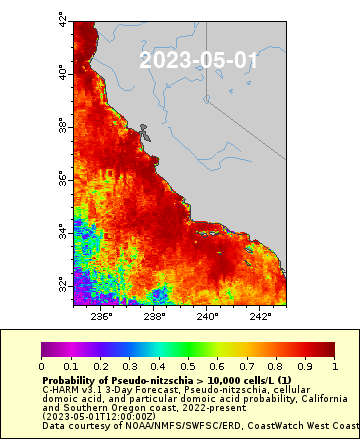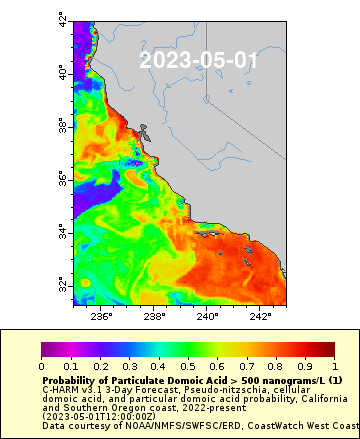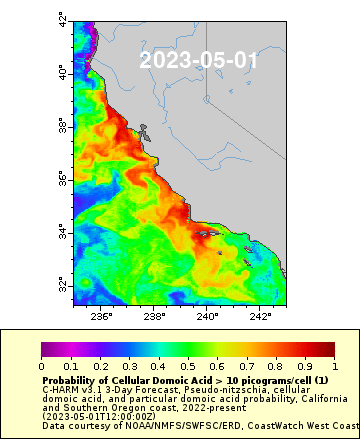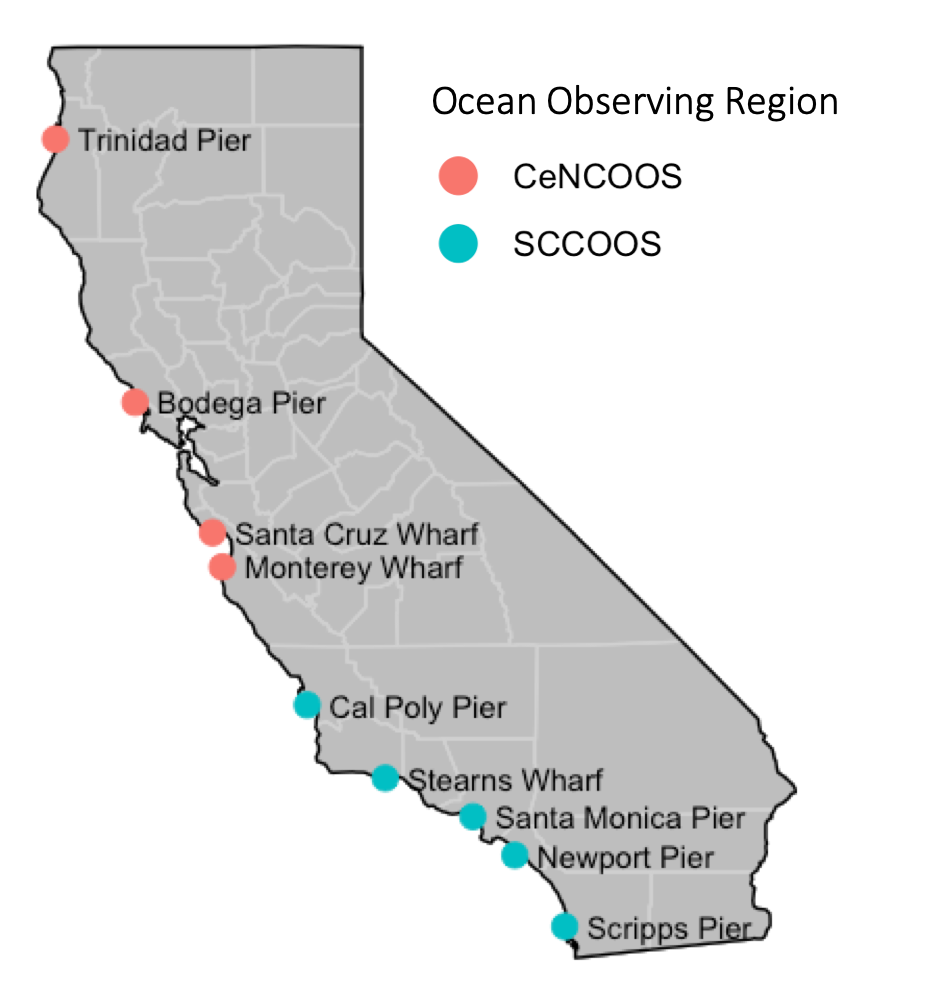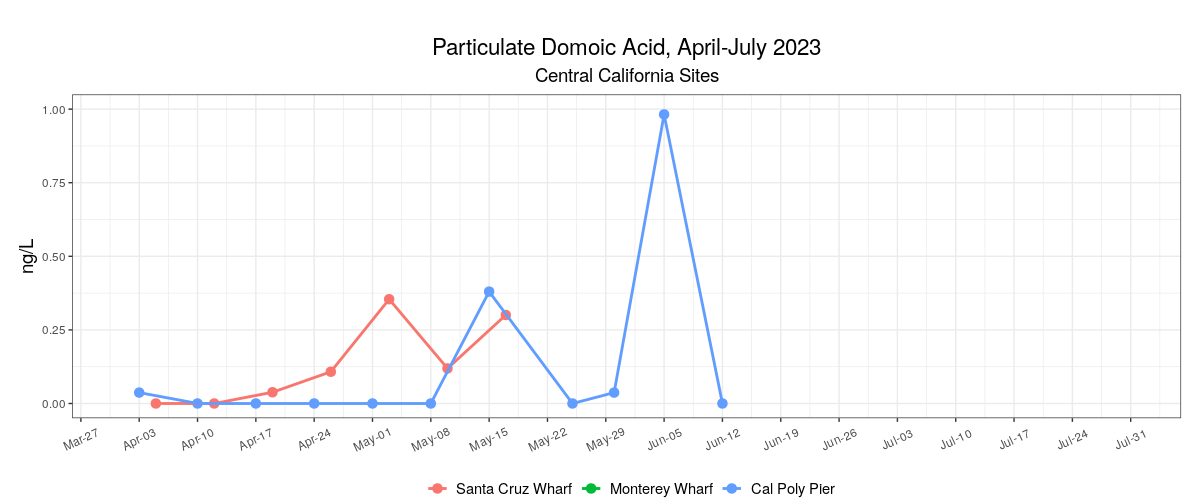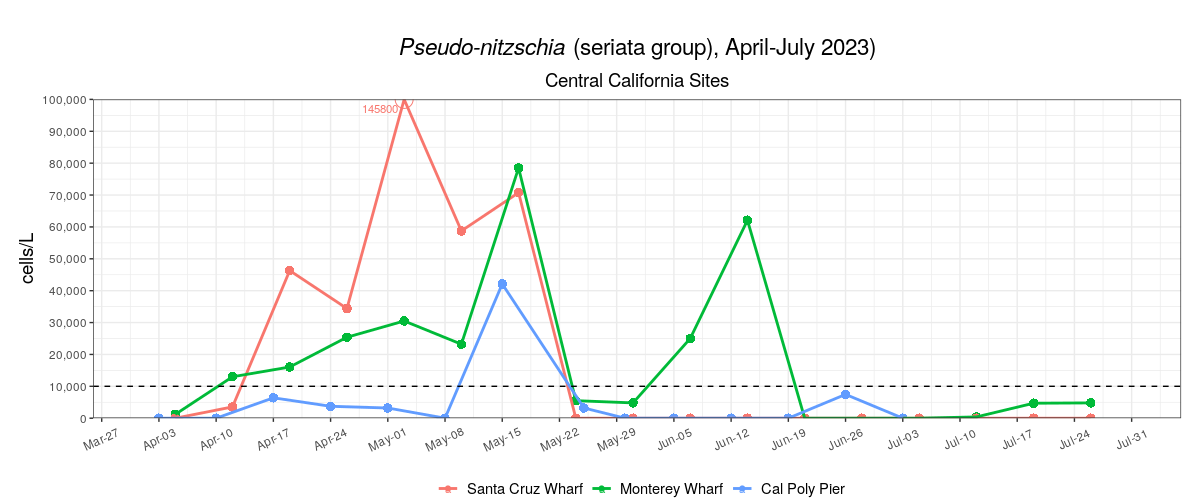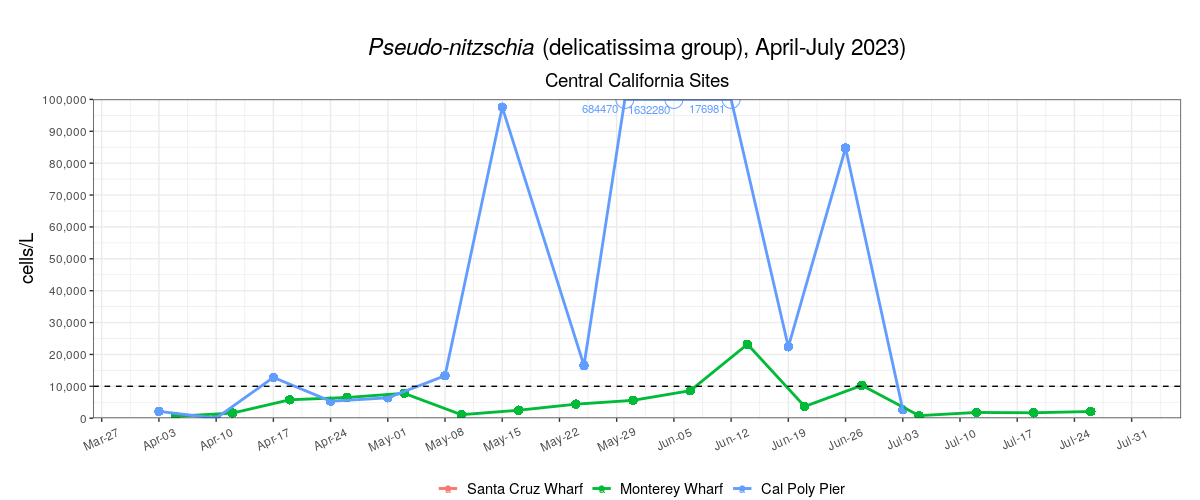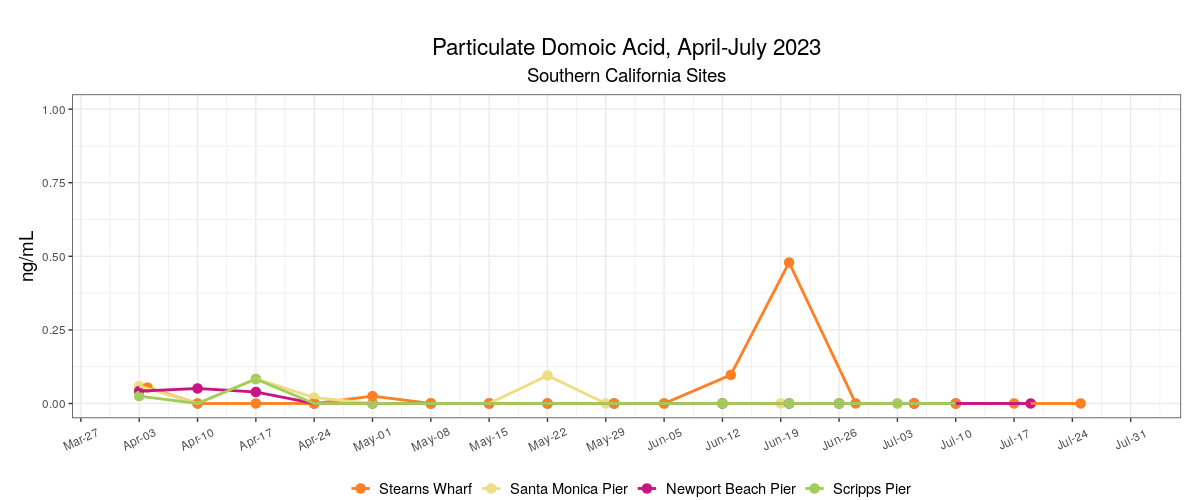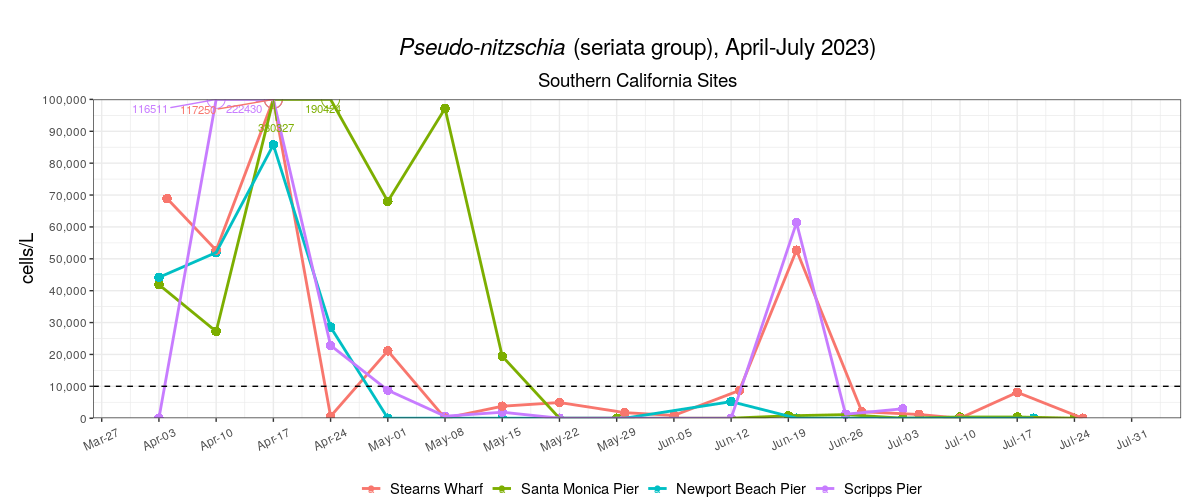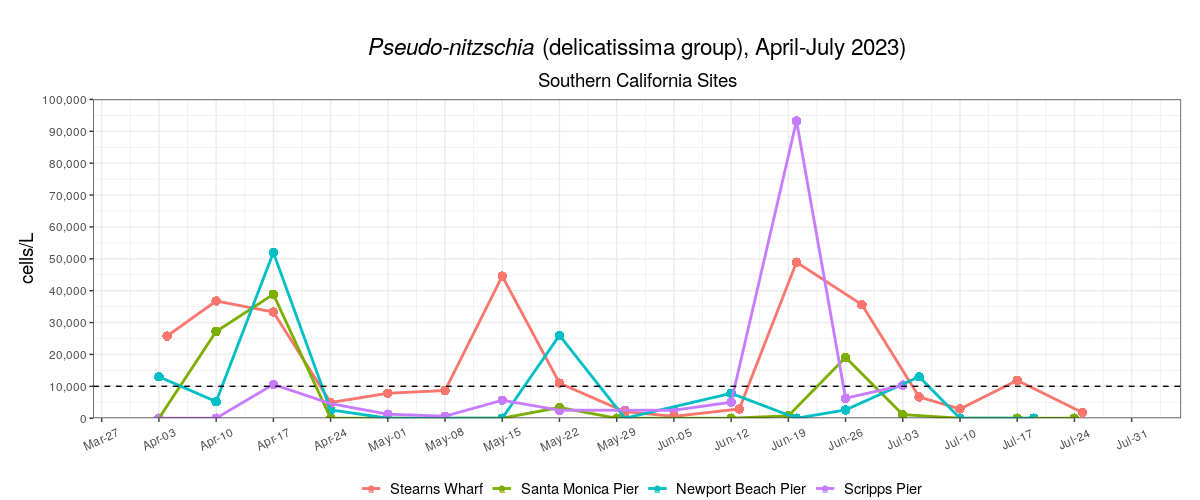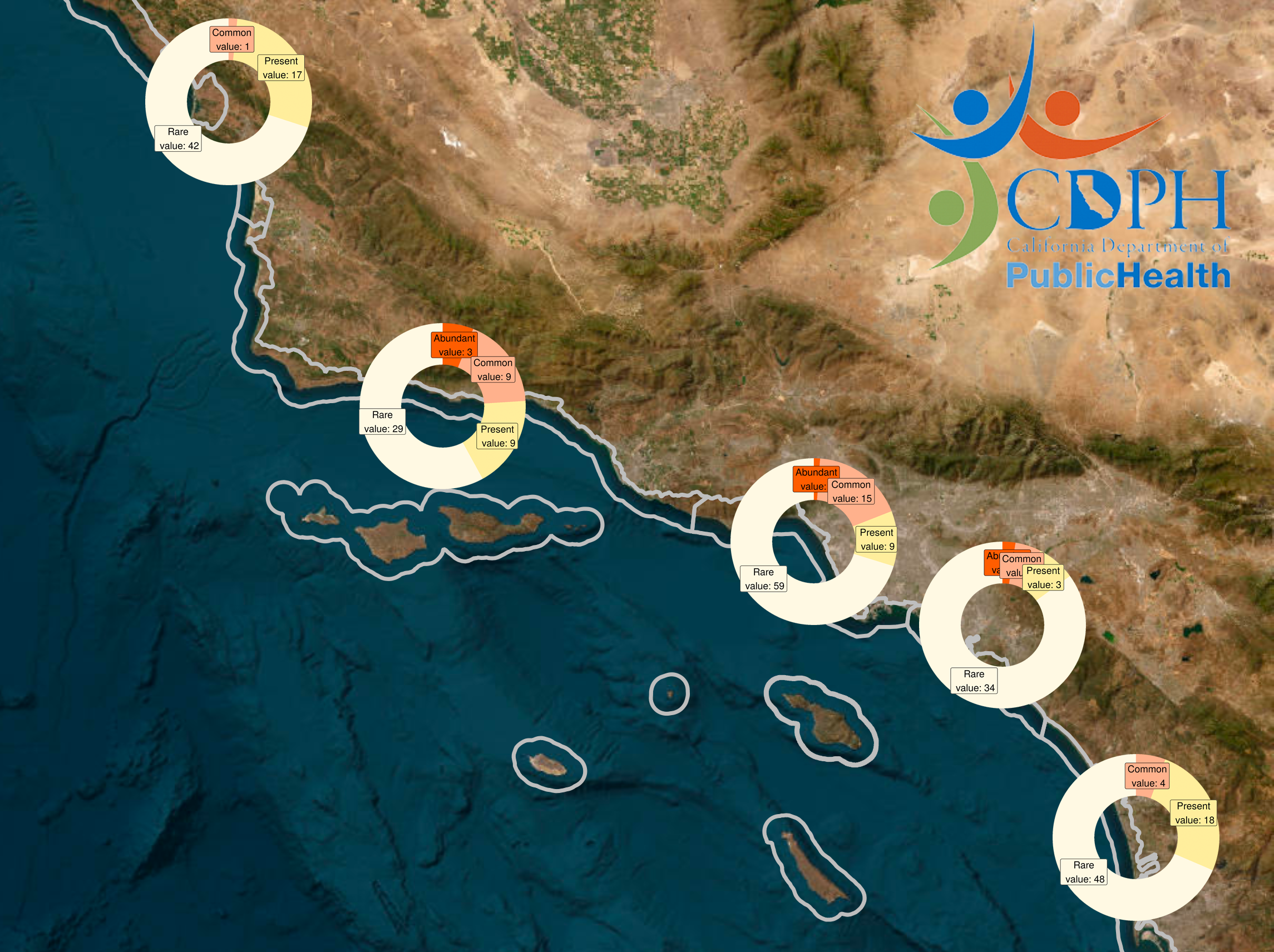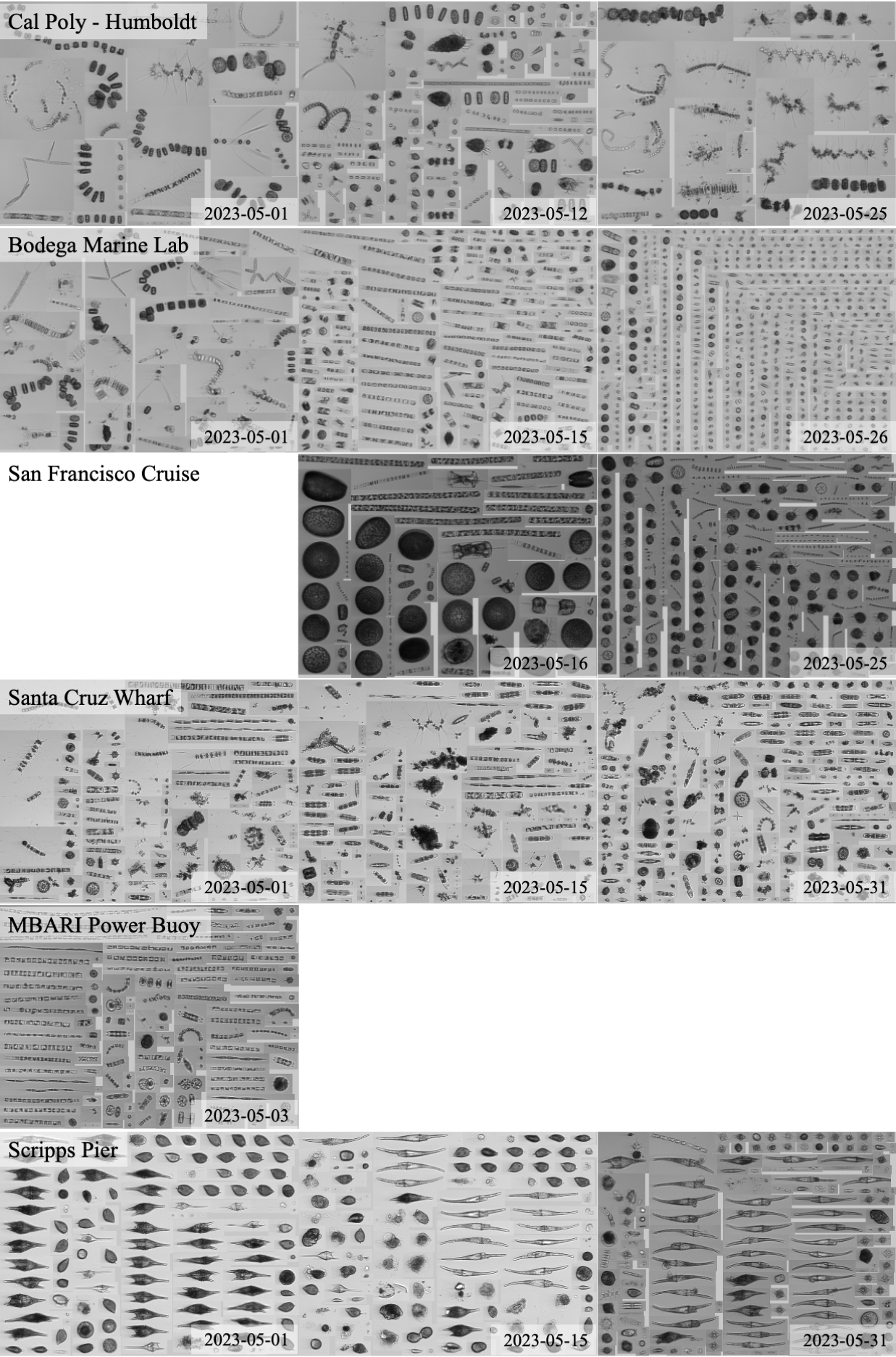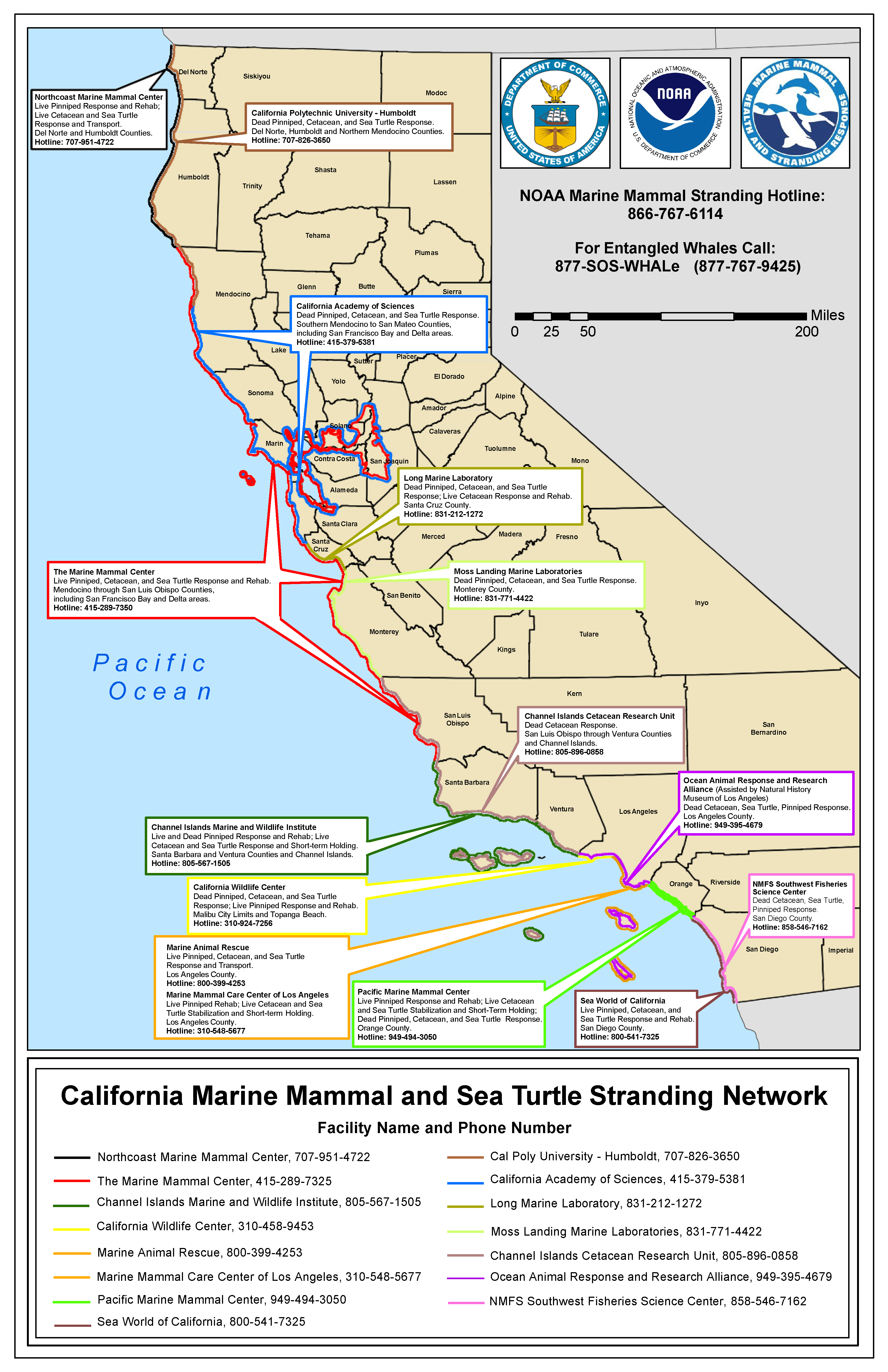MAY- JULY HIGHLIGHTS - SPECIAL ISSUE
*note: for the full suite of HAB taxa sampled weekly, see the SCCOOS and CeNCOOS HABMAP database and the Imaging FlowCytobot Dashboard.
- This special bulletin issue describes a major Domoic Acid (DA) event that lasted over a three-month period. At the end of May 2023, the first few strandings of symptomatic California Sea Lions (CSLs) began showing up on beaches, which alerted marine mammal rescue organizations to an impending problem. A week later, it was becoming clear that the dramatic increase in stranded or dead CSLs and long-beaked common dolphins throughout the Santa Barbara Channel region was likely due to DA poisoning. The tell-tale signs of the neurotoxin were prevalent in CSLs and other pinnipeds along popular beaches – lethargy, disorientation, seizures, erratic behavior – as the event expanded to encompass the region from San Luis Obispo (SLO) County in central California to San Diego County in southern California over the next few weeks. In fact, many animals displayed extreme aggression with at least seven reports of attacks, some serious, on beachgoers in the months of June and July.
- HABMAP data were consulted as early as May 25th to assess if nearshore observations were capturing a significant event. While all the sites except Scripps Pier recorded a dramatic uptick in Pseudo-nitzschia spp. in mid-to-late May, only a few of those sites reported bloom levels of the larger, more toxigenic ‘seriata’ size class, nor were those trends long-lasting, leading the HABMAP community to conjecture a possible ephemeral, nearshore bloom that rapidly advected offshore or a primarily offshore origin to the DA poisoning cases. HABMAP sampling did, however, capture a resurgence of bloom levels of the ‘seriata’ size class cells in the second half of June at Monterey Wharf (southern Monterey Bay), Cal Poly Pier (SLO), Stearns Wharf (Santa Barbara), and Santa Monica Pier (Los Angeles), suggesting a delay in onshore movement of the bloom or even a possible cycle of offshore advection followed by vertical delivery of the Pseudo-nitzschia populations onto the shelf via upwelling processes. In fact, April-May values of the Biologically Effective Upwelling Transport Index (BEUTI) were anomalously high for central California the last two years, while hovering around average for southern California. The HABMAP toxin data were not available until early July when they eventually revealed that there were elevated DA concentrations at Cal Poly Pier as early as May 15th followed by “event” levels of DA by June 5th, but by that date, the Pseudo-nitzschia population had shifted from the ‘seriata’ size class to the smaller, less toxigenic “delicatissima” size class. This decoupling between cell densities and toxin concentration is a perennial struggle for predicting DA. The biological complexity related to the subtle differences in species, strains, the ratio of particulate to dissolved toxin, and variability in coastal to pelagic toxin vectors all confound our understanding of DA production and food web transfer.
- The California Imaging FlowCytobot (IFCB) Network operates robotic microscopes at Stearns Wharf, Newport Beach Pier (Orange County), Del Mar Mooring, and Scripps Pier for high-frequency, real-time plankton imagery and identification, which would have been an ideal platform for evaluating nearshore dynamics, however, unfortunately, three out of four IFCBs in the southern California region were undergoing maintenance as this bloom developed. Interestingly, the images captured by the Scripps Pier IFCB in May show a vibrant dinoflagellate bloom close to shore, not a Pseudo-nitzschia bloom. The MBARI Power Buoy offshore in the Monterey Bay did, however, image some healthy chains of Pseudo-nitzschia in May, as shown. Daily alerts from IFCB imagery will soon be distributed to coastal managers as soon as the data pipeline is finalized.
- Synoptic, real-time estimates of the bloom were delivered by the California Harmful Algae Risk Mapping (C-HARM) System. C-HARM predictions homed in on a large swath of the central to southern California coast as an extreme hot spot for DA risk, highlighting the offshore potential for DA production and animal exposure. The predictions were in sync with animal stranding records, which was not surprising since C-HARM predictions of DA risk have been shown to correlate well with CSL stranding records. They are not well-suited, however, for predicting DA risk in most nearshore zones.
- The stranding numbers so far for 2023 exceed 1,000 for CSLs/pinnipeds and 100 for long-beaked common dolphins. In addition, 10 live dolphin strandings were reported this year, which is rather rare. Dozens of dolphin samples collected by the Channel Islands Cetacean Research Unit (CICRU) and analyzed by the Northwest Fisheries Science Center’s Wildlife Algal-Toxins Research and Response Network (NWFSC/WARRN-West, K. Lefebvre unpublished results) are yielding very high DA, as we saw with CSLs last year, with a high of 296,538 ng/g DA in feces from a dolphin collected from Ventura on June 19, 2023 and many others above 100,000 ng/g.
- From April to July, Pseudo-nitzschia activity from CDPH coastal sampling revealed 'Abundant' densities of the more toxigenic size class, Pseudo-nitzschia 'seriata,' in the Santa Barbara, Los Angeles, and Orange County regions but not in San Luis Obispo County. This is consistent with the animal strandings in those zones and also with HABMAP sampling, which mostly captured only the less toxigenic group (at very high abundances!) at Cal Poly Pier but did find seemingly brief episodes of bloom levels of the "seriata" size class in June and July at Stearns Wharf and Santa Monica Pier.
- CDPH issued amnesic shellfish poisoning (ASP) advisories for bivalves that lagged shore station DA spikes and animal strandings by almost a month, with the first alert posted on June 16th for Santa Barbara County. Interestingly, subsequent shellfish advisories issued for SLO and San Mateo Counties were due to the threat of Paralytic Shellfish Poisoning (Alexandrium/saxitoxin), not in relation to ASP. Given that the highest nearshore DA measured as part of HABMAP was at Cal Poly Pier, it is difficult to explain why no ASP advisory was ever issued for SLO County, although an annual mandatory quarantine for recreational mussel harvests is in place statewide to guard against ASP from May to October.
- SCCOOS, SIO, SCCWRP, UCSC, and The Marine Mammal Center of Sausalito thank the NOAA NCCOS HAB Event Response program for funding to better characterize the offshore extent of the bloom and levels of DA in animal tissue associated with this massive DA event. We will update this issue as new data emerge from those analyses.
Summary written on 16 August 2023 by Clarissa Anderson with contributions from Jayme Smith, Raphael Kudela, Tenaya Norris, Alissa Deming, Lauren Palmer, Ruth Dover, Michelle Berman-Kowalewski, and Kathi Lefebvre
Note that data for some stations are not shown because they are not yet recorded in the public HABMAP archive.
Differentiating Pseudo-nitzschia species by light microscopy is difficult. For this reason, Pseudo-nitzschia "seriata" does not refer to an actual species but rather the larger size class of Pseudo-nitzschia, which is generally a more toxigenic group of species. Alternatively, Pseudo-nitzschia "delicatissima" refers to the smaller size class that is generally non-toxigenic. The dashed line on the plots demarcates the 10,000 cells/L "bloom" threshold designated here for Pseudo-nitzschia populations only.
More information and data visualizations on the statewide HAB network and forecasting system can be found on the California HABMAP website and on the SCCOOS Harmful Algal Bloom page.
Click the tabs to see the Northern California HABMAP stations
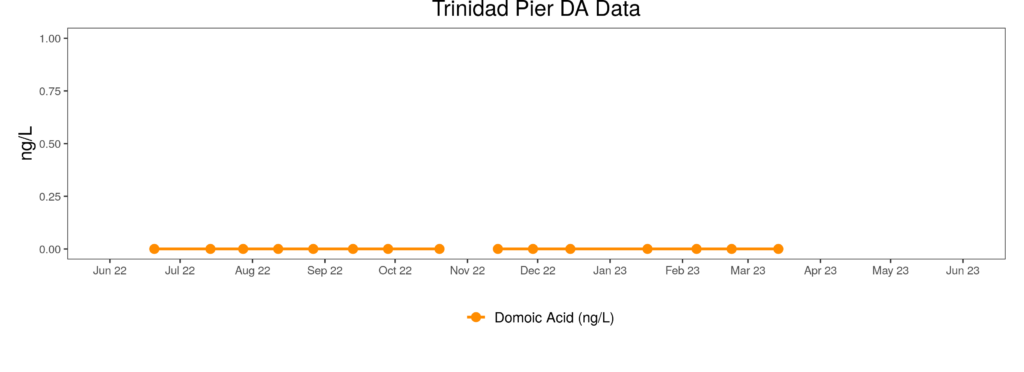
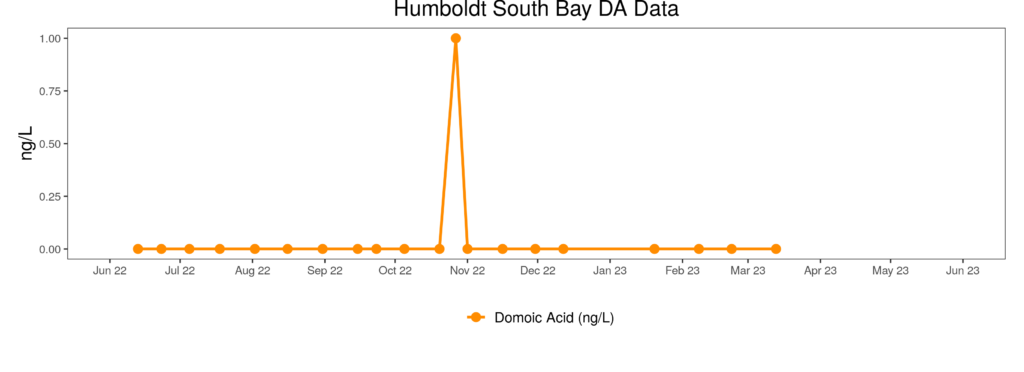
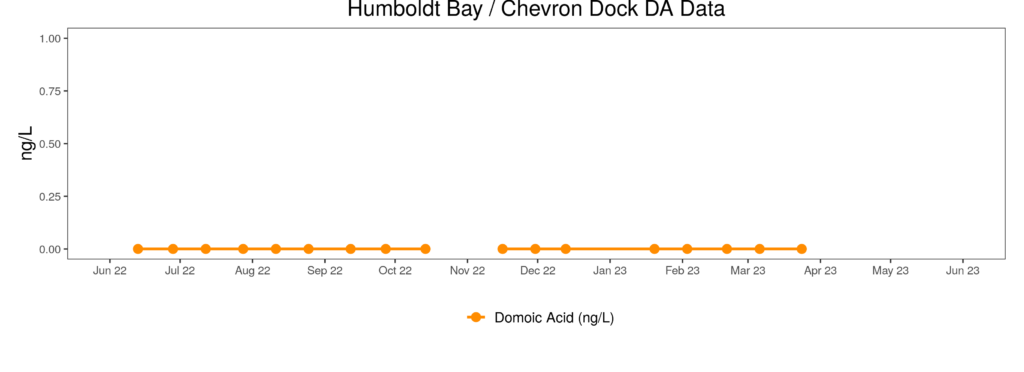
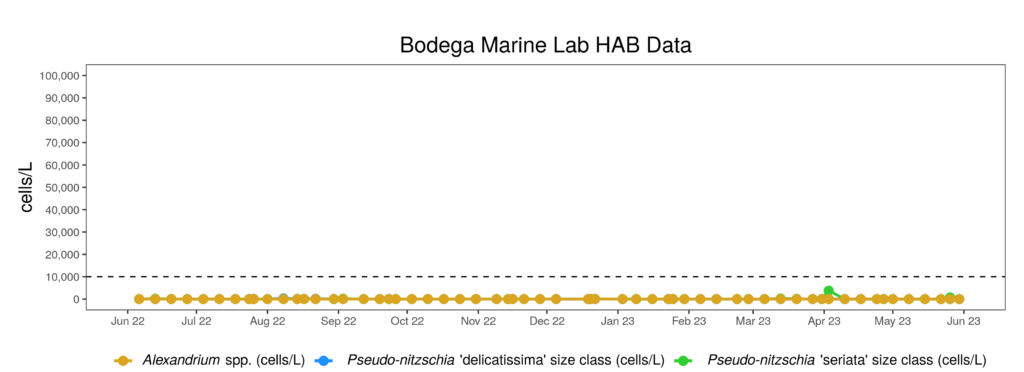
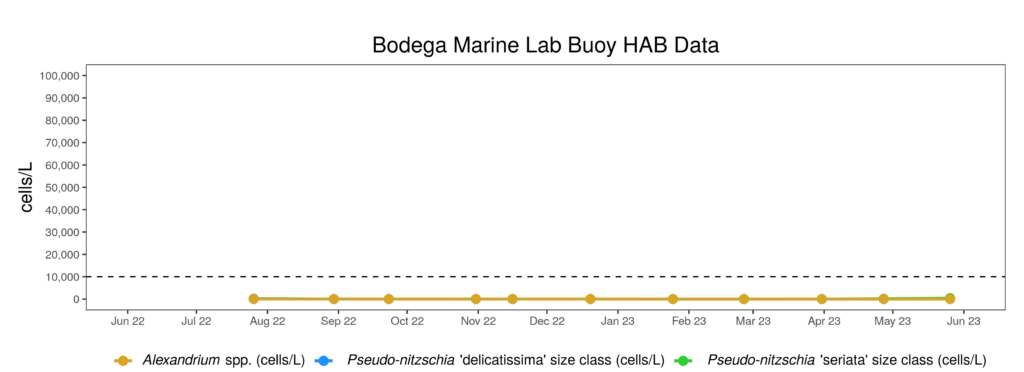
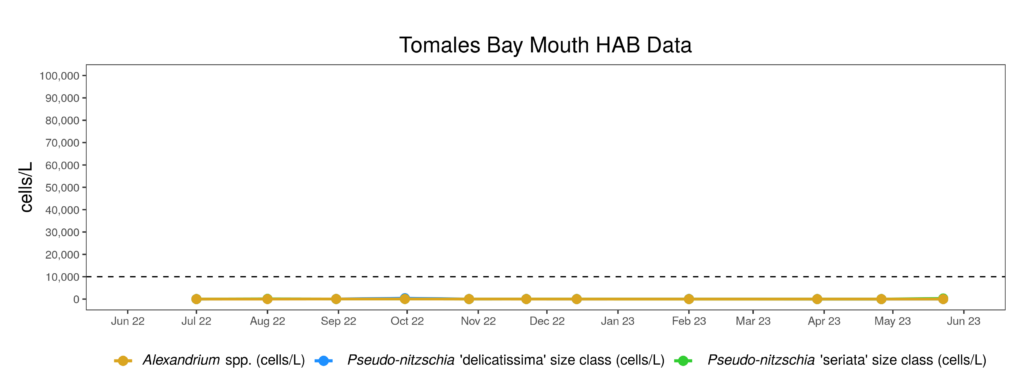
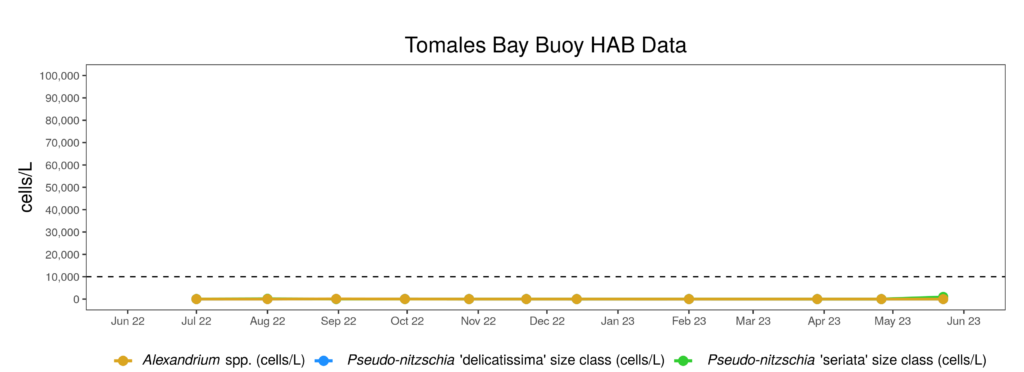
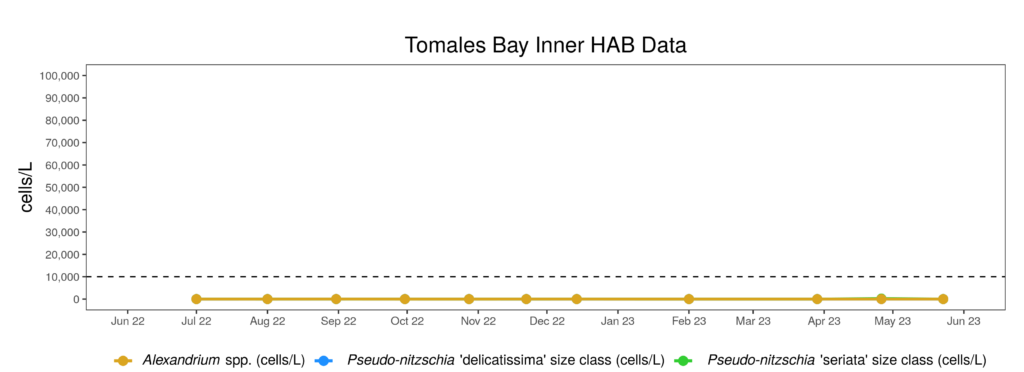
CDPH observations for Pseudo-nitzschia "seriata" and Alexandrium spp.
View the interactive map and data table of California Department of Public Health (CDPH) data from January 2019 to present, developed by SCCOOS, below. Or, view CDPH Toxic Phytoplankton Observations Map with layers of Pseudo-nitzschia and Alexandrium spp. as well as other phytoplankton species observations (in the pop-up windows).
Data are provided by the Environmental Management Branch of the CDPH. Please note, starting in July 2019, CDPH moved to only reporting Pseudo-nitzschia of the seriata complex and not all Pseudo-nitzschia spp. as previously provided.
Please email CDPH at Thomas.Hayashi@cdph.ca.gov for any potential marine HAB-related illness in humans.
Water samples were collected by volunteers and sent to the California Department of Public Health (CDPH) for analysis.
Pseudo-nitzschia "seriata" was detected at "Abundant" density levels between May and July on 7 occasions:
- 2023-05-07 60% Santa Cruz Wharf
- 2023-05-12 50% GFNMS, San Mateo Line 10E
- 2023-05-14 59% CDFG Trawl Block 478, Pescader
- 2023-05-15 58% Santa Cruz, OFFSHORE
- 2023-05-15 71% CDFG Trawl Block 501, Waddell
- 2023-05-17 61% Santa Cruz Is., Scorpion Anch.
- 2023-06-11 50% Monterey Bay
CDPH and OEHHA Health Advisories
- May 1: CDPH announced the annual quarantine of sport-harvested mussels gathered along the California coast.
- June 16: Shellfish Safety Notification: Sport-Harvested Bivalve Shellfish from Santa Barbara County Dangerous levels of domoic acid, also referred to as Amnesic Shellfish Poisoning, have been detected in mussels and oysters from Santa Barbara County.
- July 6: CDPH lifted the shellfish safety notification related to sport-harvested razor clams in Del Norte County.
- July 14: Shellfish Safety Notification: Sport-Harvested Bivalve Shellfish from San Luis Obispo County
- August 1: CDPH Lifts Warning about Shellfish from Santa Barbara County
For the latest closures and updates, please visit the CDPH Health Advisories page as a central location of information related to CDPH health advisories. Also available is a map showing the current CDPH Recreational Bivalve Shellfish Advisories (see below).
The HAB-related illness workgroup has developed a new webpage and factsheet for marine HAB-related illness tracking in English and Spanish versions.
A network of Imaging FlowCytobots (IFCBs) continuously photographs particles, such as plankton, in the water. Using machine learning, plankton species can be automatically identified. This will help improve the ability to detect and respond to Harmful Algal Blooms, including the ability to assess conditions that may lead to toxin production or blooms of toxin-producing algae.
Additional images and data are available on the IFCB dashboard.
A mosaic of IFCB images from May.
Domoic acid (DA) is a potent neurotoxin produced by some diatom species of the genus Pseudo-nitzschia. Species exposed to DA can result in seizures, epilepsy, cardiomyopathy, and death depending upon the ingested dose. DA toxicosis commonly occurs in California Sea Lions (Zalophus californianus), presumably due to a combination of foraging behavior and seasonal movements. The Marine Mammal Center (TMMC), Channel Islands Marine Wildlife Institute (CIMWI), California Wildlife Center (CWC), Marine Mammal Care Center Los Angeles (MMCC-LA), Marine Animal Rescue (MAR), Pacific Marine Mammal Center (PMMC), SeaWorld San Diego, and Southwest Fisheries Science Center (SWFSC) act like an emergency room by working to rescue and rehabilitate sick and injured marine mammals, seabirds, and sea turtles. At this time, we do not have data from the North Coast Marine Mammal Center.
From May to July 2023 over 1,000 California Sea Lion (CSL) and pinnipeds and 100 for long-beaked common dolphins. Below is our current tallies of strandings from the centers and we hope to get more detailed information as they recover from the massive influx of strandings this summer.
- The Marine Mammal Center of Sausalito = 10
- Channel Islands Marine & Wildlife Institute = 674 CSL + 100+ dolphins
- Marine Mammal Care Center - Los Angeles (CWC + MAR) = 97
- Pacific Marine Mammal Center = 105
- Sea World California = 18
Please refer to the map below for who to contact if you find a dead or stranded marine mammal, sea bird, or turtle. You can also call the West Coast Region Stranding Hotline: 1-866-767-6114. You can learn more about marine mammal strandings from NOAA Fisheries West Coast Marine Mammal Stranding Network.

